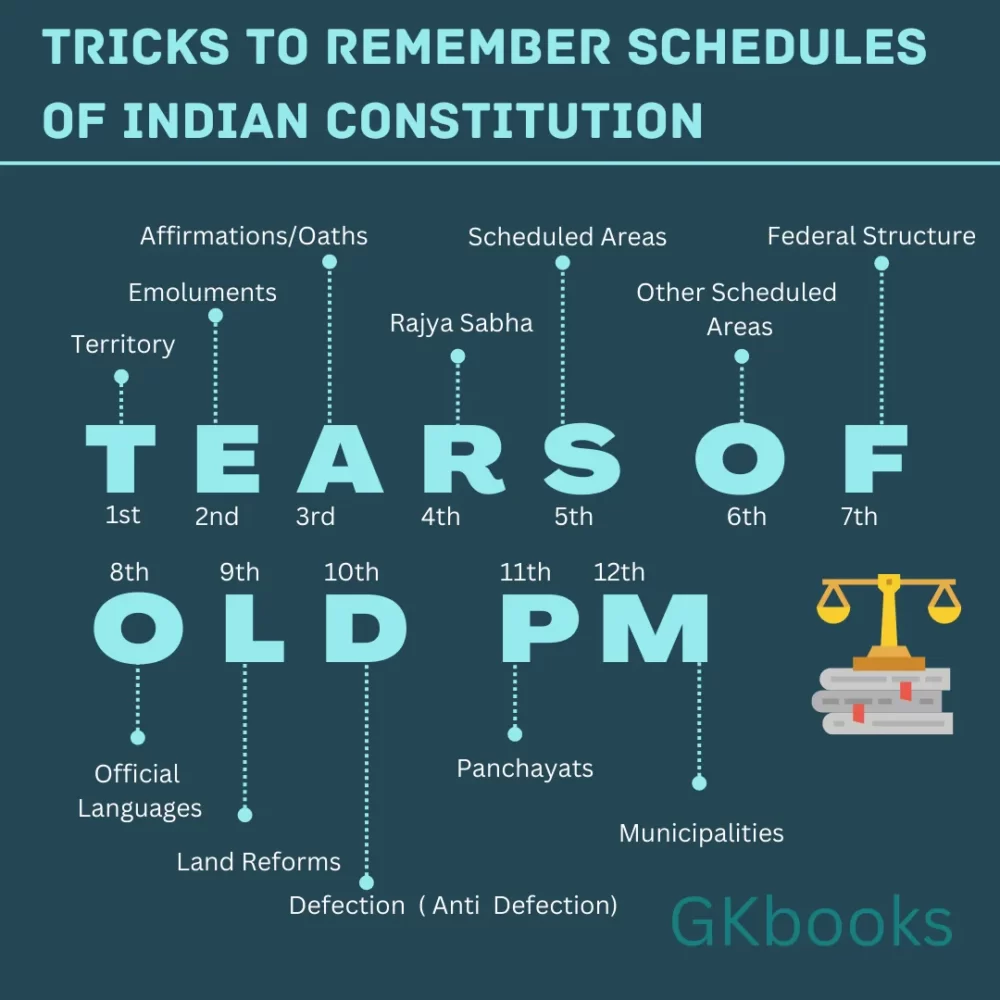Hey there, exam warriors! Cracking competitive exams like SSC, UPSC, Railways, and those state PSCs requires mastering a vast amount of information, especially within Indian Polity. One section that often throws aspirants a curveball is the Schedules of the Indian Constitution. There are twelve of them, each packed with important details. But fear not! Here’s where “Schedules of Indian Constitution Tricks: Complete Guide” comes in to save the day.
This post is your one-stop guide for unlocking the secrets of the Schedules. We’ll provide you with effective memorization techniques and easy-to-understand explanations for each Schedule. By the end of this guide, you’ll be a Schedule whiz, ready to ace that next exam with flying colors. So, what are you waiting for? Let’s dive in!
1949, when the Indian Constitution was adopted, it had 8 schedules. Currently, this number has increased to 12 as a result of various amendments to the Indian Constitution.
12 Schedules of the Indian Constitution
| Schedule | Features of Schedules | Articles |
|---|---|---|
| First Schedule |
Union and Territories • Names of the States and their territorial jurisdiction. • Names of the Union Territories and their extent. | Article 1 and Article 4 |
| Second Schedule | Provisions relating to the emoluments, allowances of_ • The President of India • The Governors of States • The Speaker and the Deputy Speaker of the Lok Sabha • The Chairman and the Deputy Chairman of the Rajya Sabha • The Speaker and the Deputy Speaker of the Legislative Assembly in the states • The Chairman and the Deputy Chairman of the Legislative Council in the states • The Judges of the Supreme Court • The Judges of the High Courts • The Comptroller and Auditor General of India | Articles list: 59 65 75 97 125 148 158 164 186 221 |
| 3rd schedule | Forms of Oaths or Affirmations • The Union ministers • The candidates for election to the Parliament • The members of Parliament • The judges of the Supreme Court • The Comptroller and Auditor General of India • The state ministers • The candidates for election to the state legislature • The members of the state legislature • The judges of the High Courts | Articles list: 75 84 99 124 146 173 188 219 |
| Fourth Schedule | Allocation of seats in the Rajya Sabha to the states and the union territories | Article 4 & Article 80 |
| Fifth Schedule | Provisions relating to the administration and control of scheduled areas and scheduled tribes. | Article 244 |
| Sixth Schedule | Provisions relating to the administration of tribal areas in the states of Assam, Meghalaya, Tripura and Mizoram | Article 244 and Article 275 |
| Seventh Schedule |
Division of powers between the Union and the States. It has three legislative lists: • List I (Union List) • List II (State List) • List III (Concurrent List) • Presently, the Union List contains 98 subjects (originally 97) • The State List contains 59 subjects (originally 66) and • The Concurrent List contains 52 subjects (originally 47) | 246 |
| Eighth Schedule | Official Languages • Originally, it had 14 languages • At present there are 22 languages. • Assamese • Bengali • Bodo • Dogri (Dongri) • Gujarati • Hindi • Kannada • Kashmiri • Konkani • Mathili (Maithili) • Malayalam • Manipuri • Marathi • Nepali • Odia • Punjabi • Sanskrit • Telugu • Urdu • Sindhi • Santhali • Tamil
• Sindhi was added by the 21st Amendment Act of 1967 | Article 344 and Article 351 |
| Ninth Schedule | Acts and Regulations (originally 13 but presently 282)32 of the state legislatures dealing with land reforms and abolition of the zamindari system and of the Parliament dealing with other matters. ◘ This schedule was added by the 1st Amendment (1951) | Article 31-B |
| Tenth Schedule | Anti Defection Law • Provisions relating to disqualification of the members of Parliament and State Legislatures on the ground of defection | Articles:
• 102 • 191 |
| Eleventh Schedule | Panchyats • Specifies the powers, authority and responsibilities of Panchayats. • It has 29 matters. • This schedule was added by the 73rd Amendment Act of 1992. | Article 243-G |
| Twelfth Schedule | Municipalities • Specifies the powers, authority and responsibilities of Municipalities. • It has 18 matters. • This schedule was added by the 74th Amendment Act of 1992. | Article 243-W |
✅ Indian Polity MCQ: Asked in Previous Year’s WBCS Preliminary Exams [300 MCQs]
Tricks to remember schedules of the Indian constitution
• Here is a simple trick to remember all Schedules of the Indian Constitution.
• Remember the Sentence “TEARS OF OLD PM”
• Here, each letter of this sentence refers to a specific schedule in the Indian Constitution.
For Example __
• T – Territory
• E – Emoluments
• A – Affirmations and Oaths
• R – Rajya Sabha
• S – Scheduled Areas
• O – Other Scheduled Areas
• F – Federal Structure
• O – Official Languages
• L – Land Reforms
• D – Defection (Anti-Defection Law)
• P – Panchayats
• M – Municipalities

Frequently Asked Questions (FAQ)
Answer: 395 Articles and Tota 12 schedules
Answer:
Territory
Emoluments
Affirmations and Oaths
Rajya Sabha
Scheduled Areas
Other Scheduled Areas
Federal Structure
Official Languages
Land Reforms
Defection (Anti-Defection Law)
Panchayats
Municipalities
Answer: Tota 12 schedules
Answer: 395 articles in 22 parts and 8 schedules
Answer. The Tenth Schedule
More Related Posts:
- Citizenship of India UPSC Notes: Indian Polity Notes
- Union and its Territory Notes: Part I (Articles 1- 4)
- The Preamble of the Indian Constitution: Full Explanation
- Difference between Lok Sabha and Rajya Sabha: Complete Details
- Attorney General of India: Complete Details

